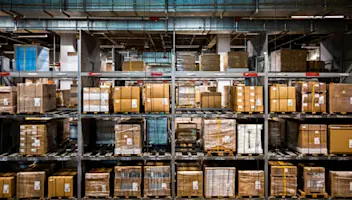How to Master Being a Drop Ship Vendor – Part II – The Tools for Success
How to Master Being a Drop Ship Vendor – Part II – The Tools for Success
How to Master Being a Drop Ship Vendor – Part II – The Tools for Success
2 Feb 2021
Ken Weygand
You may have the right team, the right skillsets, the right ideas—but you also need the right tools.
As online shopping becomes more popular, drop shipping has also increased in popularity. To keep up with the demands of retailers and the high volumes associated with DTC shipping, it's critical for consumer goods distributors to efficiently process orders and get product out the door quickly.
You need the right tools to position yourself for success. An all-in-one consumer goods ERP offers communication efficiencies, warehouse management processes, inventory and forecasting solutions, and product tracking tools to ensure you can master being a drop-ship vendor.
Really, it's all about getting your goods out efficiently and on time. Disparate systems, systems that aren't integrated, that don't seamlessly exchange data, and require manual entry and work, aren't going to cut it anymore. It's the harsh reality of consumer shopping habits. They want more, and they want it now.
And in the time of COVID, all of those drop-shipping challenges are still there. Just like they've always been there. Now, though, there's more volume. For some consumer goods businesses, they're creating product at an unprecedented rate—doing double or triple the business they were doing this time last year. They've had to figure out a way to get their goods out the door effectively and efficiently.
If you haven't read part one of this little series, we encourage you to check it out. The blogs work together to fully explore the ins-and-outs of being a drop-ship vendor. And in part one, we addressed the challenges often associated with drop-shipping product:
Changing consumer buying habits
Real-time information exchange
Managing shipments efficiently
Streamlining processes
Now, we're going to explore how you can combat and overcome these challenges.
Changing Consumer Buying Habits
There remains a big unknown in terms of consumer buying habits: what will buying preferences look like post-COVID? That's the big question, isn't it? Will we once again be out and about visiting retail brick and mortar stores like before? Or will consumers have become more comfortable with buying online and having the product delivered to their doors?
The latter seems most likely. Even though COVID further altered how consumers shop and buy, the truth is the landscape has been changing for years. And for importers and distributors of consumer goods, if you're not in the ecommerce market now, you want to begin to shift in that direction.
Because that's the way people are shopping. And here's the harsh reality: if you're not willing to change to accommodate these new shopping habits, the world is going to move on without you.
There are purpose-built software solutions you can utilize to help you effectively manage this ecommerce transition. Tools that enable you to easily:
Fulfill an order
Ensure the right inventory and labor to pick, pull, pack and ship
Shift from traditional full pallet and truck shipping
Re-engineer your warehouse processes to accommodate the new fulfillment model
Change is always hard. And scary. But the right software can make the transition to ecommerce sales and distribution less so. And in the long term, it'll be worth it. Because not only are you able to do all the things we just listed here, but you're able to do so much more.
Real-time Information Exchange
It would help if you had a solution that can exchange data and information in real-time.
The second you write down information, it becomes outdated. A solution that updates data in real-time and can easily communicate those changes eliminates all the challenges associated with manual data entry.
With an industry-specific, consumer goods and imports ERP, you're stepping away from an antiquated multi-system environment and stepping into a solution that scales and grows as your business does. All your information is in one place, works across departments, streamlines processes and stores all your data for reporting and analysis.
You don't have to worry about integration issues because all the data is already there.
A consumer goods ERP is the solution that can connect you to a multitude of ecommerce platforms. That can enable you to manage DTC fulfillment easily. That can provide you with information on availability.
It has built-in EDI and WMS capabilities, has API connectivity, offers validations (on pricing and addresses, for example), can provide acknowledgments and tracking information, and the best part: it gives you all of this information in real-time.
Managing Shipments Efficiently
So much of shipment efficiency comes down to the warehouse. To smooth, quick processes. To automation. To real-time visibility.
To secure this kind of efficiency, several things must happen:
Reduce the time it takes to pull product and pack each order.
You do this by reducing touchpoints. Your ERP can help you with this.
Let's say, as an example, you have 20 orders. And you walk up and down the aisles, picking the product for each of those 20 orders individually. For each of those orders, you're pulling product, placing it at a pack station, where each order is then packed and shipped one by one. That's the traditional model—how things have worked before.
But we can simplify this process. Rather than walk the aisle 20 times to pick those orders, you bulk pull—you walk the aisles once and pull all the product you need to fulfill all 20 orders. This, quite literally, means time back in your day—time to re-dedicate to more orders or more pressing tasks.
Bulk pull all the product you need instead of walking the same aisles over and over.
Let's continue with the previous example. Each of those 20 orders can be picked, packed and out the door if you don't have to spend so much time walking up and down the aisles.
Maybe you have a cart with you, so not only are you picking the product across those 20 orders, but you're keeping them organized. And maybe simultaneously picking and packing so that as you're walking the aisles and picking the product, you're placing it in a shippable carton. That way, in the end, there's no repacking of product that has to take place.
It’s also worth noting that the traditional methods of picking and pulling can’t scale as volume grows. Your stuck going up and down those aisles again and again and again. A bulk pull and pack process, however, does sale and does allow you to adjust for increased drop-ship volume.
A consumer goods ERP supports this kind of workflow, and if you don't have this shipping flow in place, it's a solution that can help you create one.
Avoid using multiple systems to produce labels and paperwork.
Are you able to produce parcel labels at the point you'd like to have them? If no, it's time to reevaluate your current solution. You should have the option to print the label at a pack station or have it in the aisle when you're picking it and placing it in the carton. It's small adjustments like these that make the difference. That's time back in your day, money back in your pocket. And you can create these processes, these new efficiencies and communicate them widely within your ERP.
Have product properly slotted.
Your ERP system should be flexible in setting up your warehouses so that you can define your zones, areas and bin locations as it best suits your business. You should also have the flexibility to adjust the rules based on your operations.
It’s essential you have the ability to apply settings within each of those zones related to inventory management, bulk picking/staging, put-away, receiving, replenishment and picking. You should be able to configure which warehouse workers should be active in each zone within your warehouse and which operations they're allowed to perform.
Enable your operators with hand-held devices.
By providing your operators with hand-held devices, you're streamlining the data entry process. It's real-time inventory tracking and accuracy and leaves no time for picking errors. All the information your operators need is with them as they move throughout the warehouse.
Automate data entry.
No more onerous, frustrating hours spent manually keying in data. No more unintentional human error. No more outdated data. No more rearview mirror decisions.
Everything is up to date. Everything is accurate. This is the reality for you and your business with an industry-specific ERP. This is how you master being a drop-ship vendor.
Streamlining Processes
So much of mastering drop-shipping comes down to streamlining processes. If you were to break down each of these categories to its bare bones, it'd be about efficient, streamlined processes.
Here we want to highlight a couple more things that an industry-specific ERP can do for you in terms of mastering drop-shipping.
Credit card automation - You also want to quickly and efficiently process credit card transactions—either during the order or afterward. The process by which your customers pay invoices should be as easy as possible. You want to get paid. Make it easy for your customer to pay you.
Product information management - When you're updating your ecommerce website, you want to know how and where to find all that production information—the product attributes, the availability, the price changes, etc. With Aptean Distribution ERP, you can store all this data in a central location to be communicated and shared electronically with those who need it.
Sales tax - As a consumer goods distributor in an ecommerce world, you're likely going to have sales taxes to worry about. Depending on the number of states in which you operate, there may be multiple rules and rates with which you must comply. Not to mention, these rules and rates change all the time. You want to streamline this as much as possible with an all-in-one ERP solution. Rather than using multiple systems to calculate taxes and regulations, using a single system where all your data lives makes maintaining and regulating this information that much easier.
Because of all of this, you need a solution that's going to work with you. One that's going to enable your business to grow. To become more efficient. To succeed despite the challenges. To master the drop-shipping challenges. Aptean can help.
And if you're looking for a bit more detail than what we've provided here, download our ultimate How-To Guide for the Drop-Shipping Revolution. We made it just for you.
Ready for what's next in imports, DTC and consumer goods distribution? Reach out, now.
Related Content


Sind Sie bereit, Ihr Unternehmen grundlegend zu verändern?
Wir bieten Ihnen die spezialisierten ERP-Lösungen, die Sie für die Herausforderungen Ihrer Branche benötigen.






